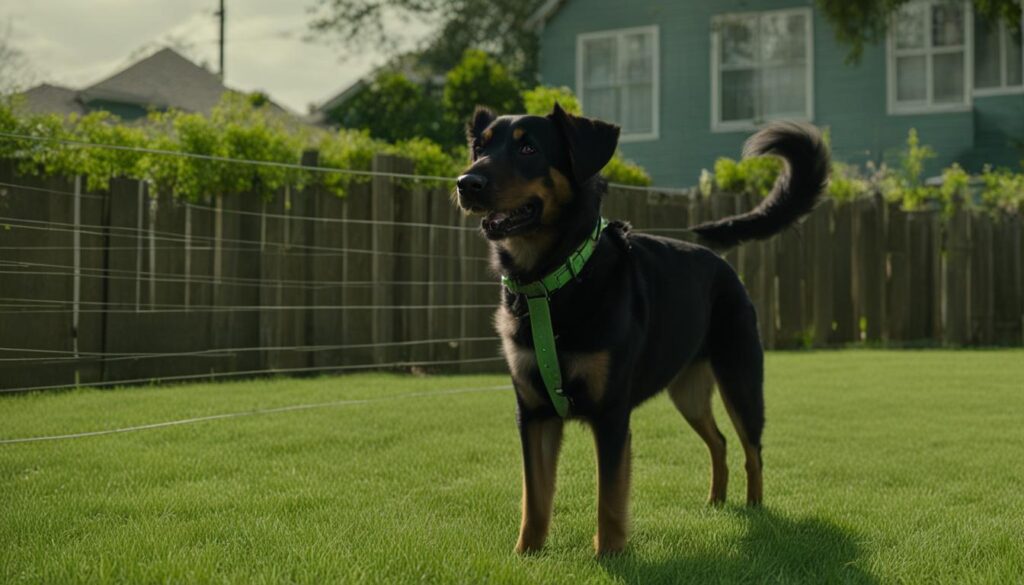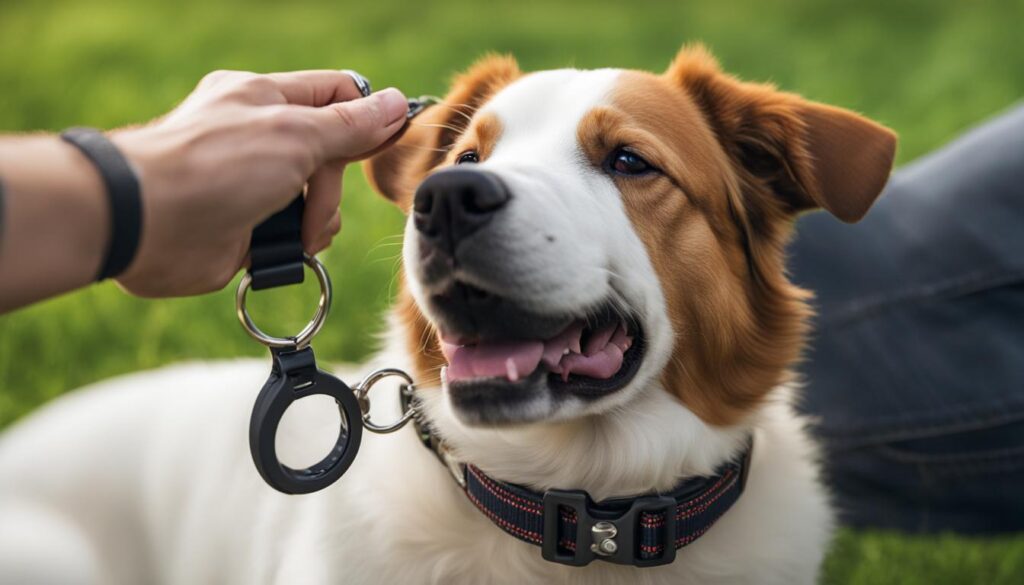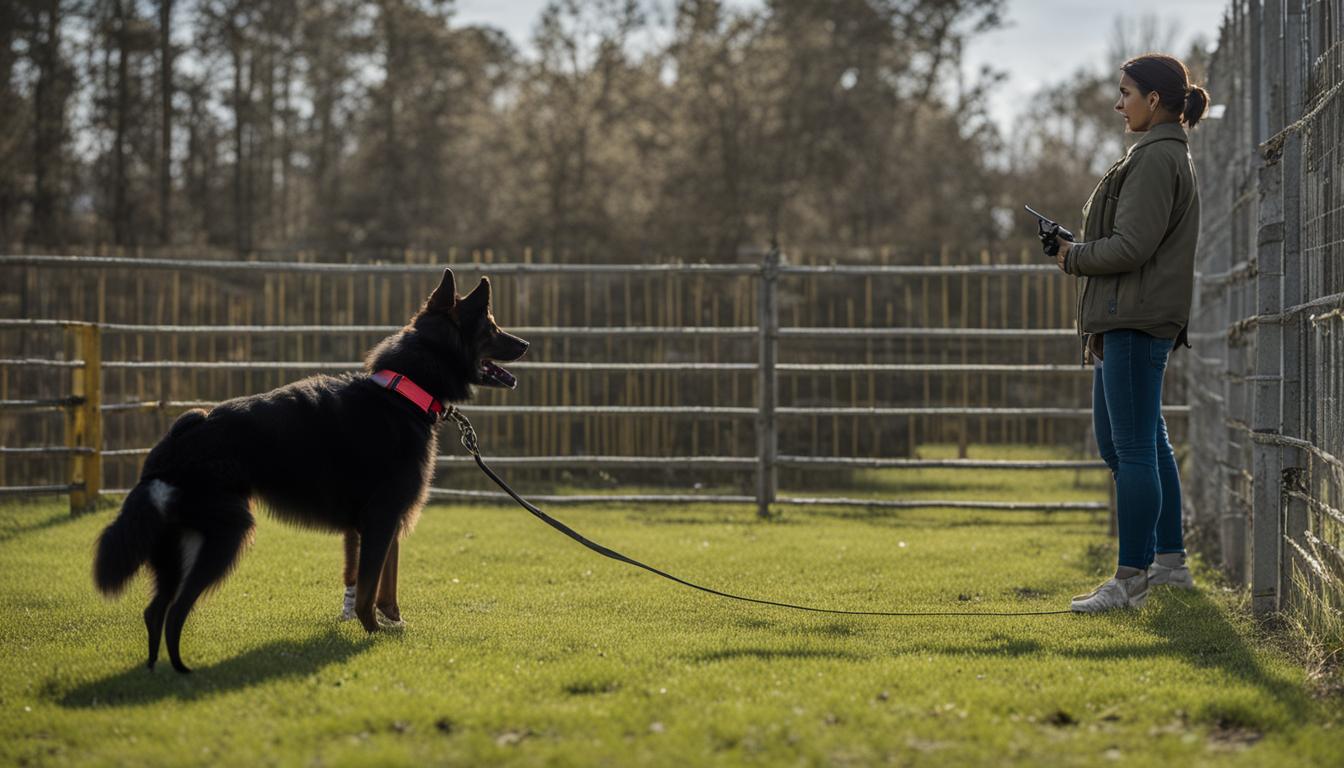Training your dog to respect boundaries is essential for their safety and well-being. One effective tool for boundary training is a shock collar. In this guide, we will walk you through the steps of How to Use Shock Collar for Boundary Training in Dogs to establish clear boundaries for your dog.
Key Takeaways – Train a Dog with a Shock Collar
- Introduce the shock collar gradually and ensure it is fitted properly
- Use positive reinforcement techniques alongside the shock collar
- Set clear boundaries and be consistent in your training
- Train your dog to recognize warning stimulation
- Increase the shock level only if necessary and monitor your dog's response
Introducing Your Dog to the Shock Collar
When embarking on boundary training with a shock collar, it is crucial to properly introduce your dog to this new tool. Start by ensuring the collar is fitted comfortably around your dog's neck – not too tight to cause discomfort or too loose to slip off.
Begin the introduction with the lowest intensity level to assess your dog's reaction. Allow your dog to become familiar with the presence of the collar before moving forward. This initial phase is key to establishing a positive association with the electric shock collar.
As you introduce the shock collar, incorporate positive reinforcement techniques to create a positive experience for your dog. Use treats, praise, and rewards alongside the collar to reinforce desired behaviors or boundaries. By combining the shock collar with positive reinforcement, you can effectively teach your dog the desired boundaries while maintaining a loving and supportive environment.
Remember to observe your dog's response and adjust the shock collar accordingly. It is essential to prioritize your dog's comfort and safety throughout the training process. Consistency and patience are crucial as your dog learns and adapts to the shock collar and the boundaries it represents.
Steps – Train a Dog Boundaries with a Shock Collar
| Step | Action |
|---|---|
| 1 | Ensure proper collar fit |
| 2 | Start with lowest intensity level |
| 3 | Allow dog to become comfortable with the collar |
| 4 | Use positive reinforcement alongside the collar |
| 5 | Observe and adjust according to dog's response |
By introducing your dog to the shock collar in a gradual and positive manner, you can lay the foundation for successful boundary training. Remember to always prioritize your dog's well-being and tailor the training approach to their individual needs and temperament.
Set Clear Boundaries with the Electronic Collar


Once your dog is comfortable with the shock collar, it is time to set clear boundaries. Dogs are creatures of habit and consistency, so it is important to establish consistent boundaries that they can understand. Begin by showing your dog the boundary using verbal and hand signals, clearly indicating where they should not cross. This helps them understand the physical limits of their space and reinforces the concept of boundaries.
When your dog approaches or crosses the boundary, use the shock collar to correct their behavior. Start with lower shock levels and only increase the intensity if necessary. It is crucial to be consistent in your training and to provide positive reinforcement alongside the shock collar.
This means praising and rewarding your dog when they exhibit the desired behaviors and stay within the boundaries. Positive reinforcement helps them associate the boundaries with positive experiences, making it easier for them to understand and adhere to the limits you have set.
Benefits of Clear Boundaries
Setting clear boundaries with a shock collar provides several benefits for both you and your dog. Firstly, it enhances safety by preventing your dog from wandering off into dangerous areas or getting into potentially harmful situations. It also promotes good behavior and obedience, as your dog learns to respect and follow the established boundaries. This can improve their overall behavior and make them easier to manage both at home and in public settings.
| Benefits of Clear Boundaries | |
|---|---|
| Enhanced safety | Prevents dogs from entering dangerous areas |
| Promotes good behavior | Teaches dogs to respect and follow boundaries |
| Improved manageability | Makes dogs easier to handle at home and in public |
Clear boundaries also help to strengthen the bond between you and your dog. When they understand and follow the boundaries you have set, it creates a sense of trust and respect, which can deepen the bond between you. By consistently reinforcing the boundaries with positive reinforcement and using the shock collar as a tool for correction, you can effectively teach your dog the importance of respecting boundaries and maintaining good behavior.
Remember to be patient and consistent with your training. Dogs may take time to fully understand and internalize the boundaries.
By providing clear signals, using positive reinforcement, and using the shock collar as a correction tool when necessary, you can effectively teach your dog to respect and adhere to the boundaries you have set. With time and consistent training, your dog will learn to navigate their environment safely and within the established limits.
Train Your Dog to Recognize Warning Stimulation


To effectively establish boundaries using a shock collar, it is crucial to train your dog to recognize warning stimulation. This step is vital in helping your dog understand when they are approaching the boundary and avoid crossing it. By associating the warning stimulation with the desired behavior, you can effectively communicate the boundaries to your dog.
Start by using the warning stimulation in conjunction with verbal cues and hand signals to indicate to your dog that they are nearing the boundary. Ensure consistency in your training and reward your dog with a treat and praise when they respond correctly to the warning stimulation. Repeat this process consistently until your dog confidently recognizes and responds to the warning stimulation.
By training your dog to recognize the warning stimulation, you are providing them with the tools to make the correct choices and stay within the established boundaries. Remember to always use positive reinforcement techniques alongside the shock collar for an effective and humane training experience.
Create a Safe and Controlled Training Environment
When training your dog to recognize warning stimulation and adhere to boundaries using a shock collar, it is essential to create a safe and controlled training environment. This ensures the effectiveness of the training and prioritizes your dog's well-being.
Eliminate distractions from the training area and ensure that there are no potential hazards that could harm your dog. Supervise the training sessions closely to ensure that your dog is responding positively to the warning stimulation and staying within the designated boundaries.
Consistency and patience are key during the training process. Stay calm and avoid becoming frustrated if your dog takes some time to understand the concept. Remember to reinforce the desired behaviors with positive reinforcement techniques, such as treats and praise, to encourage your dog's progress.
Monitor Your Dog's Response to Warning Stimulation
During the training process, it is crucial to closely monitor your dog's response to the warning stimulation. Pay attention to any signs of anxiety or discomfort and adjust the training accordingly. Every dog is unique, and their response to the shock collar may vary.
Ensure that the shock collar is properly fitted and not causing any discomfort or harm to your dog. If you notice any adverse reactions or consistently negative responses, consider seeking guidance from a professional dog trainer or veterinarian who can provide you with expert advice tailored to your dog's needs.
Increase the Shock Level if Necessary
If your dog continues to cross the boundaries despite the lower shock levels, it may be necessary to increase the intensity of the shock. However, it is crucial to proceed with caution and prioritize your dog's safety and well-being. Always start at the lowest shock level and monitor your dog's response closely. Increase the shock level gradually and only if absolutely necessary.
Adjusting the shock collar for your dog's response requires careful observation and assessment. Pay attention to your dog's behavior and their reaction to the shock. If they are still not deterred from crossing the boundaries, slightly raise the shock intensity. Remember, the goal is to teach your dog to recognize and respect the boundaries, not to cause unnecessary harm or discomfort.
Keep in mind that every dog is unique, and their tolerance for shock may vary. Some dogs may be more sensitive to shocks, while others may require a higher intensity to respond effectively. It is always best to err on the side of caution and consult with a professional dog trainer or veterinarian for guidance.
| Steps to Increase Shock Level: | Things to Consider: |
|---|---|
| Start at the lowest shock level | Monitor your dog's response closely |
| Observe your dog's behavior | Ensure your dog's safety and well-being |
| If necessary, slightly raise the intensity | Consult with a professional for guidance |
| Continue using positive reinforcement | Adjust shock collar based on individual dog's needs |
“Increasing the shock level should always be a last resort. It is essential to prioritize your dog's safety and emotional well-being throughout the training process. Remember to use positive reinforcement techniques alongside the shock collar to reinforce the desired behaviors and boundaries.” – Professional Dog Trainer
Supervise and Provide Positive Reinforcement


Supervising your dog during boundary training with a shock collar is essential to ensure their safety and well-being. While the shock collar can be an effective tool, it should never be used as a substitute for your presence and attention. Always be present and attentive while your dog is wearing the collar to prevent any potential harm or confusion.
Consistency is crucial in shaping your dog's behavior, so be sure to provide positive reinforcement during the training process. Use treats, praise, and rewards to reinforce the desired behaviors and boundaries. Positive reinforcement creates a positive association and motivates your dog to continue exhibiting the correct behavior. Remember, positive reinforcement is more effective than punishment and helps strengthen the bond between you and your furry friend.
Monitoring your dog's response to the shock collar is essential to gauge their progress and make any necessary adjustments. Observe how your dog reacts to the warning stimulation and determine if they understand the associated boundaries. If your dog continues to cross the boundaries despite the lower shock levels, it may be necessary to gradually increase the intensity of the shock.
However, always prioritize your dog's safety and well-being, and seek professional help if you find yourself frequently needing to use the highest intensity shock level.
Tips for Boundary Training with a Training Collar
- Start with a clear plan and be consistent in your training approach.
- Establish a routine and dedicate regular sessions to boundary training.
- Use marker flags or other visual cues to further establish the boundaries.
- Gradually reduce the reliance on the shock collar as your dog becomes more familiar with the boundaries.
- Continue reinforcing positive behaviors with praise and rewards even after your dog has mastered the boundaries.
By supervising your dog, providing positive reinforcement, and monitoring their response to the shock collar, you can effectively train them to respect boundaries and ensure their safety.
Conclusion
Using a shock collar for boundary training in dogs can be an effective tool when introduced gradually and used correctly. It offers an additional means of communication to establish clear boundaries and reinforce desired behaviors. When combined with positive reinforcement techniques, the shock collar can help shape your dog's behavior and keep them safe within designated boundaries.
However, it is important to approach the use of shock collars with caution. It is essential to prioritize your dog's well-being and consult with a professional dog trainer or veterinarian before implementing this training method. Every dog is unique, and it is crucial to tailor the training approach to suit your dog's individual needs and temperament.
As with any training tool, shock collars have their pros and cons. On the positive side, they can be effective in training dogs to recognize and respect boundaries. They provide consistent correction and can be a valuable aid in reinforcing commands. However, it is important to be mindful of potential drawbacks, such as the risks associated with improper use, the potential for negative side effects, and the potential for the dog to become desensitized to the collar over time.
In conclusion, the use of shock collars for boundary training in dogs should be approached with caution and used as part of a comprehensive training program. Prioritize the well-being of your dog and ensure that you are following proper guidelines and techniques. Incorporate positive reinforcement methods alongside the use of the shock collar to create a balanced and effective training approach. By doing so, you can establish clear boundaries, reinforce desired behaviors, and ultimately, ensure the safety and happiness of your canine companion.
FAQ – How to Use Shock Collar for Boundary Training in Dogs
How can I use a shock collar to train my dog to stay within the boundary?
To train the dog to stay within the boundary using a shock collar, you should first ensure that the dog needs to be familiar with the collar. Then, using the collar as a deterrent, consistently reinforce the boundary line by delivering a low-level shock when the dog attempts to cross it. It's crucial to teach your dog to stay within the set boundaries using positive reinforcement training and to make sure your dog understands the area limit.
What type of collar should I use for boundary training?
When it comes to boundary training, you can use a remote training collar or electronic collar to train your dog to adhere to the boundaries. This allows you to use the collar to deliver corrections and reminders from a distance, making it an effective tool to train a dog to stay within the defined area.
Is shock collar training the only method to keep my dog safe within boundaries?
While shock collar training can be effective in boundary training, it's not the only method available. You can also train the dog using positive reinforcement training techniques to teach your dog to stay within the boundaries without the need for using an electronic collar. It's essential to explore all available options prior to resorting to using a shock collar.
How long does it take to train a dog to stay within the set boundaries using a shock collar?
The time it takes to train a dog to adhere to the set boundaries using a shock collar varies for each dog. It depends on the dog’s collar responsiveness, the consistency of training and reinforcement, and the effectiveness of your training methods. It's important to be patient and allow time for the collar to work in teaching your dog to stay within the boundaries.
What precautions should dog owners take when using a shock collar for boundary training?
When using a shock collar for boundary training, dog owners should take precautions such as carefully adjusting the intensity of the shock to avoid causing unnecessary pain to the dog. They should also ensure that the collar is properly fitted and regularly check for any signs of irritation or discomfort on the dog's neck. It is important to use the shock collar as a last resort and only under the guidance of a professional trainer.
How should I introduce my dog to the shock collar for boundary training?
Begin by familiarizing your dog with the collar and gradually increase the intensity of the shock as needed. Use positive reinforcement techniques alongside the shock collar to create a positive association and teach your dog the desired behaviors or boundaries.
How do I set clear boundaries with the shock collar?
Show your dog the boundary using verbal and hand signals, and use the collar to correct them if they cross the boundary. Start with lower shock levels and gradually increase as needed. Be consistent in your training and use positive reinforcement alongside the shock collar to reinforce the desired behaviors.
How can I train my dog to recognize warning stimulation from the shock collar?
Use the warning stimulation to signal to your dog that they are approaching the boundary. Pair the warning with verbal cues and reward your dog with a treat when they respond correctly. Repeat this process until your dog reliably recognizes the warning stimulation and understands the associated boundaries.
What should I do if my dog continues to cross the boundaries despite the lower shock levels?
If your dog continues to cross the boundaries, it may be necessary to increase the intensity of the shock. Always start at the lowest level and gradually increase only if absolutely necessary. Monitor your dog's response closely and seek professional help if needed.
How should I supervise my dog during boundary training with a shock collar?
It is important to be present and attentive while your dog is wearing the collar. Consistency in your training is crucial, so provide positive reinforcement in the form of treats, praise, and rewards when your dog exhibits the desired behaviors and stays within the boundaries.
Are shock collars effective for boundary training in dogs?
When introduced gradually and used correctly, shock collars can be an effective tool for boundary training. However, it is important to consider the potential drawbacks and consult with a professional before using a shock collar. Tailor the training approach to best suit your dog's needs and temperament.





